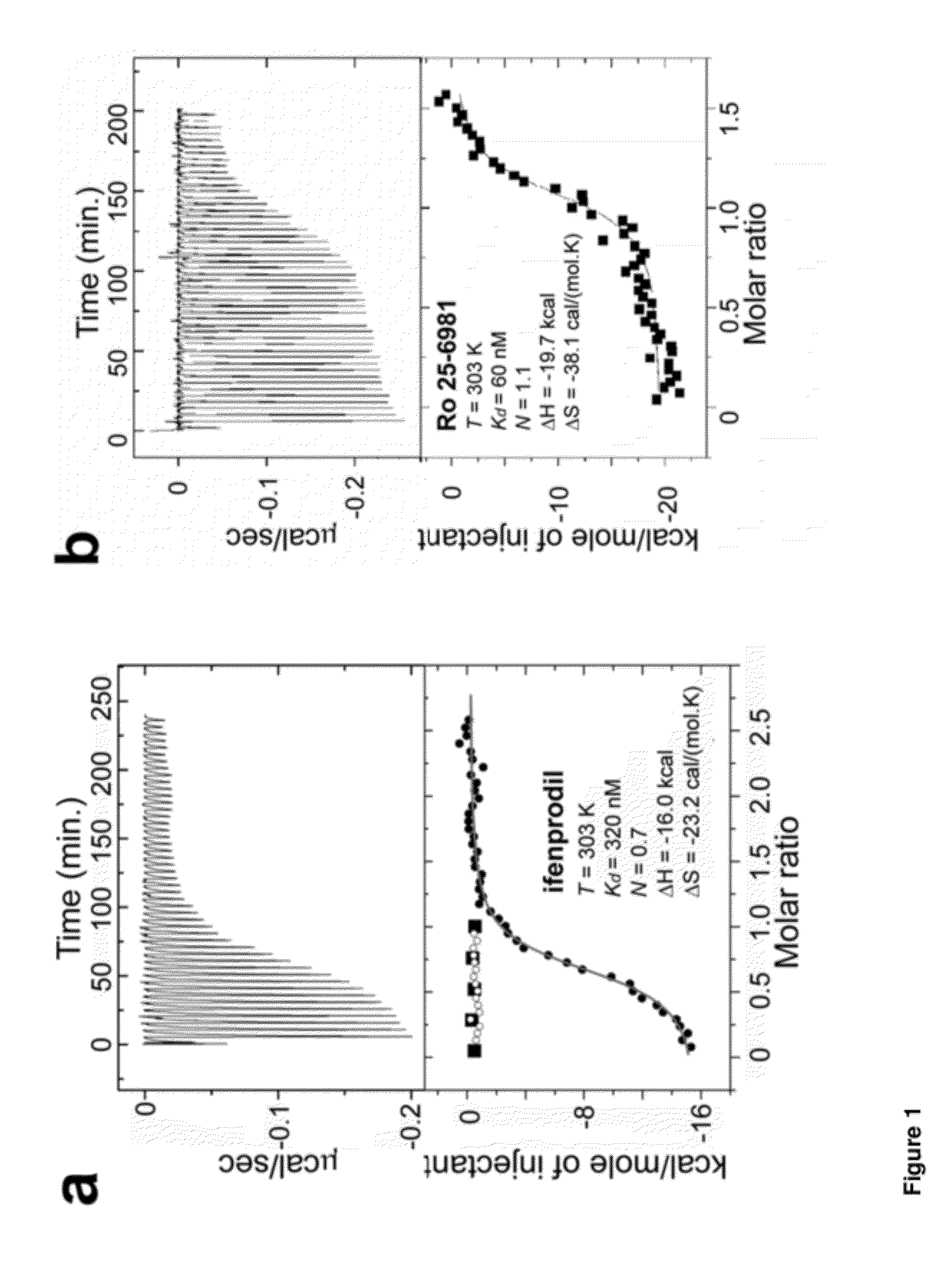Phenylethanolamine-based NMDA receptor antagonists
a technology of phenylethanolamine and nmda receptor, which is applied in the field of phenylethanolamine-based nmda receptor antagonists, can solve the problems of limited design and development of additional therapeutic phenylethanolamine-based compounds for use as neuroprotectants
- Summary
- Abstract
- Description
- Claims
- Application Information
AI Technical Summary
Benefits of technology
Problems solved by technology
Method used
Image
Examples
example 1
[0238]There have been limited studies probing a direct binding of phenylethanolamine-based compounds, such as ifenprodil, to the isolated ATD of NMDA receptors. Consequently, the true requirement for receptor-compound binding has remained unclear. In order to detect direct binding of phenylethanolamine-based compounds to the ATD of the NMDA receptor, ATD proteins derived from the Xenopus laevis GluN1-4b (GluN1b ATD) and the Rattus Norvegicus GluN2B (GluN2B ATD) were recombinantly expressed, and the purified proteins were used to quantify heats resulting from direct binding of ifenprodil and Ro 25-6981 by isothermal titration calorimetry (ITC) (FIG. 1a-1b and FIG. 2). The Xenopus laevis GluN1-4b (Ewald et al., 2009; Schmidt et al., 2009), with superior biochemical stability over other orthologues was used in this study. It is 93% identical in primary sequence to the Rattus Norvegicus orthologue and is capable of forming functional NMDA receptor ion channels that undergo ifenprodil in...
example 2
[0240]To understand the nature of the subunit interaction between GluN1b and GluN2B at ATD and to pinpoint a binding site for phenylethanolamine-based compounds on the NMDA receptor, crystallographic studies were conducted on the GluN1b / GluN2B ATD proteins. Toward this end, the structure of GluN1b ATD was first solved at 2.0 Å by a single anomalous diffraction method using seleno-methionine incorporated crystals (FIG. 4). Subsequently, the structures of GluN1b / GluN2B ATD in complex with ifenprodil and Ro 25-6981 were determined at 2.6 Å and 3.0 Å, respectively, by molecular replacement using structural coordinates of the GluN1b ATD and GluN2B ATD (Karakas et al., 2009) monomers as search probes (FIGS. 5 and 6).
[0241]Both the ifenprodil-bound and Ro 25-6981-bound crystals contained two copies of structurally similar GluN1b / GluN2B ATD heterodimers per asymmetric unit with root-mean-square (r.m.s.) deviation of 0.51 Å and 0.58 Å, respectively. Most importantly, the crystal structures c...
example 3
[0244]Extensive mutagenesis studies in the past have indicated GluN1b Tyr109 (Masuko et al., 1999) and GluN2B Phe176 (Perin-Dureau et al., 2002) and Asp236 (Perin-Dureau et al., 2002) to be critical in ifenprodil-inhibition. Further mutagenesis on the newly identified residues from both GluN1b and GluN2B in this study showed significant alteration in IC50 or the extent of inhibition (FIG. 10d, Tables 1-3), confirming the physiological relevance of the binding site. Disruption of the “empty” hydrophobic space formed by GluN1b Ala75, GluN2B Ile82 and Phe114 (arrows in FIG. 10a-b) by site-directed mutations had dramatic effects on ifenprodil-sensitivity (FIG. 10d). Thus, stabilization of this hydrophobic space by filling in with a hydrophobic moiety may be a valid strategy to improve the design of phenylethanolamine-based drugs.
[0245]While inspection of the primary sequences showed non-conservation of the critical binding site residues between GluN2B and GluN2C or GluN2D (such as the e...
PUM
| Property | Measurement | Unit |
|---|---|---|
| concentration | aaaaa | aaaaa |
| hydrophobic | aaaaa | aaaaa |
| synaptic plasticity | aaaaa | aaaaa |
Abstract
Description
Claims
Application Information
 Login to View More
Login to View More - R&D
- Intellectual Property
- Life Sciences
- Materials
- Tech Scout
- Unparalleled Data Quality
- Higher Quality Content
- 60% Fewer Hallucinations
Browse by: Latest US Patents, China's latest patents, Technical Efficacy Thesaurus, Application Domain, Technology Topic, Popular Technical Reports.
© 2025 PatSnap. All rights reserved.Legal|Privacy policy|Modern Slavery Act Transparency Statement|Sitemap|About US| Contact US: help@patsnap.com



